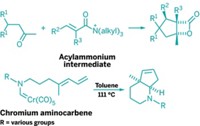Advertisement
Grab your lab coat. Let's get started
Welcome!
Welcome!
Create an account below to get 6 C&EN articles per month, receive newsletters and more - all free.
It seems this is your first time logging in online. Please enter the following information to continue.
As an ACS member you automatically get access to this site. All we need is few more details to create your reading experience.
Not you? Sign in with a different account.
Not you? Sign in with a different account.
ERROR 1
ERROR 1
ERROR 2
ERROR 2
ERROR 2
ERROR 2
ERROR 2
Password and Confirm password must match.
If you have an ACS member number, please enter it here so we can link this account to your membership. (optional)
ERROR 2
ACS values your privacy. By submitting your information, you are gaining access to C&EN and subscribing to our weekly newsletter. We use the information you provide to make your reading experience better, and we will never sell your data to third party members.
Synthesis
Chemists build a triple norbornane
After exploring a computer-generated ‘chemical space’ database, team takes on the challenging synthesis of a new polycyclic hydrocarbon
by Stephen K. Ritter
October 16, 2017
| A version of this story appeared in
Volume 95, Issue 41

As molecular explorers, chemists often venture out into “chemical space” to see what strange new discoveries they can make. To assist in these efforts, researchers have devised algorithms that take a prescribed set of elements and number of atoms and work through all the possible combinations leading to stable molecules that are synthetically feasible. Using the GDB-11 database, which constructs molecules containing C, N, O, or F and containing up to 11 framework atoms, a team led by Marcel Mayor of the University of Basel decided to zoom in on polycyclic hydrocarbons lacking three- or four-membered rings. This structural motif is sometimes found in natural products that have potential as drug candidates. Among the 124 molecules that popped up in the database search, only three had no real-world counterparts. One of these compounds, an intricate symmetrical saturated C11H16 molecule, was “particularly appealing and eye catching,” so the researchers decided to try to make it (Chem. Commun. 2017, DOI: 10.1039/c7cc06273g). The compound’s scaffold consists of two norbornane units that share a pair of neighboring edges, an arrangement that coincidentally results in a third norbornane subunit. Using a total synthesis strategy similar to the way chemists go about preparing natural products, the researchers succeeded in making a racemic mixture of the chiral compound, which they have named trinorbornane, in nine steps with 7% overall yield.





Join the conversation
Contact the reporter
Submit a Letter to the Editor for publication
Engage with us on Twitter